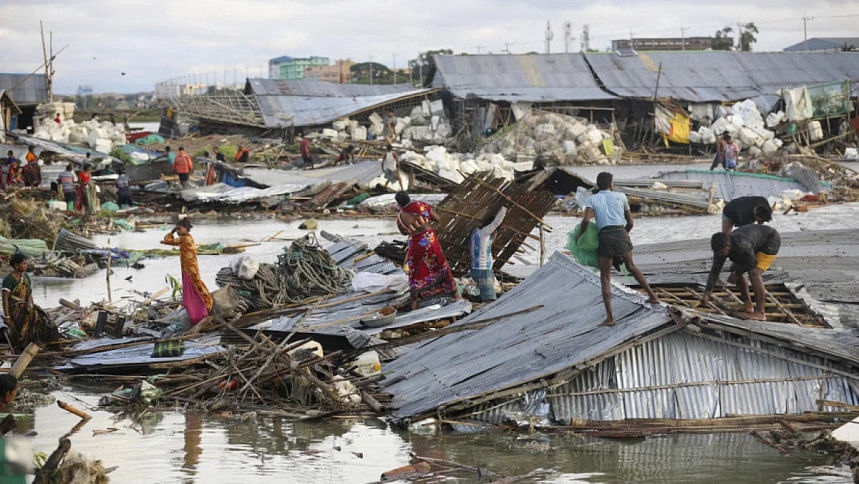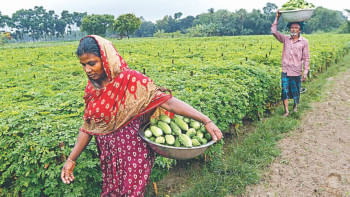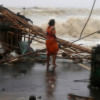The ground reality of disaster risk governance in Bangladesh

Bangladesh, a low-lying deltaic country with a subtropical climate and flat topography, is highly vulnerable to natural disasters. Climate change has intensified hazards such as floods, cyclones, salinity intrusion, river erosion, landslides, and droughts. Over the past two decades, 185 extreme weather events have caused 11,450 deaths and resulted in economic losses amounting to $3.72 billion. Ranked 7th on the Global Climate Risk Index, Bangladesh faces growing threats from natural disasters.
Effective disaster risk governance is essential to minimise the impact on lives and livelihoods. Despite the high exposure of the country, where over two-thirds of the population live in multi-hazard risk areas, Bangladesh has made notable progress in developing sound policies and institutional arrangements aligned with global standards. However, the operationalisation of these policies and the functionality of the institutional frameworks remain key concerns.
The evolution of Bangladesh's disaster risk governance policy began in 1997 with the introduction of the country's first Standing Orders on Disaster (SOD-1997), which established a regulatory framework for disaster risk management across all administrative levels. In response to evolving needs, the SOD was revised in 2008. The most recent version, SOD-2019, further strengthens the disaster management regulatory framework and enhances coordination mechanisms at the district, upazila, paurashava, and union levels. SOD-2019 also introduces a clear command-and-control structure, ensuring a well-defined chain of authority from national to local-level institutions responsible for disaster risk governance.
In 2011, Bangladesh introduced its first hazard-specific policy: the Cyclone Shelter Construction, Maintenance, and Management Policy. The following year, the Disaster Management Act 2012 was enacted, establishing the key legislative framework that defines the roles and responsibilities of disaster management organisations. The National Disaster Management Policy was formulated in 2015 to outline strategies for reducing disaster risks and improving post-disaster response.
Alongside these policies, Bangladesh has implemented the National Plan for Disaster Management (NPDM) since 2010—a five-year strategic plan aligned with national priorities and global frameworks, including the Sendai Framework for Disaster Risk Reduction (2015–2030). To date, three NPDMs have been developed, covering 2010–2015, 2016–2020, and 2021–2025. Each plan identifies priority actions to strengthen disaster risk reduction and resilience over its respective period, providing an institutional foundation to guide the country's ongoing disaster management efforts.
To translate disaster governance policies into practice, Bangladesh maintains a multi-tiered institutional arrangement. At the local level, the District Disaster Management Committee (DDMC) serves as the primary authority for disaster-related governance and coordination within districts. This structure extends downward to the upazila level through the Upazila Disaster Management Committees (UzDMCs), and further to the union and ward levels via the Union Disaster Management Committees (UDMCs) and Ward Disaster Management Committees (WDMCs), respectively. In urban and semi-urban areas, disaster governance is led by City Corporation Disaster Management Committees and Municipality Disaster Management Committees.
DDMCs, chaired by deputy commissioners with support from District Disaster Relief and Rehabilitation Offices, generally meet the membership criteria of the Standing Orders on Disaster (SOD). While meetings are convened during emergencies, regular engagement during non-emergency periods—critical for planning and institutional learning—is often lacking, resulting in partial non-compliance with the SOD. Capacity building for communities and stakeholders, a key SOD responsibility of the DDMCs, also faces significant challenges. Many DDMCs struggle to conduct training and awareness activities due to limited financial and logistical resources.
Although some vulnerable districts collaborate with NGOs and development partners to strengthen local risk management, these efforts are inconsistent. NGOs, constrained by their own resource limitations, and a recent decline in funding, have further weakened local disaster preparedness and risk reduction efforts. Addressing these gaps is essential to ensure compliance with the SOD and enhance effective disaster management on the ground.
The Upazila Disaster Management Committee (UzDMC), led by the upazila nirbahi officer (UNO), plays a crucial role in disaster planning and implementation. UzDMCs have made progress in forming Union Disaster Management Committees (UDMCs), organising awareness and capacity-building activities, coordinating stakeholders, and developing local disaster plans. However, they face several challenges. Many committees lack inclusive representation, particularly of women and persons with disabilities, as required by the SOD. Community-Based Risk Reduction Action Plans are often NGO-driven, with limited understanding among committee members. UzDMCs also struggle with resource constraints and frequently rely on support from influential locals, as district-level funds are often delayed.
Although emergency shelters are generally functional, creating inclusive and enabling environments—especially for vulnerable groups—remains a challenge. Addressing these issues is essential to strengthen the effectiveness, inclusivity, and responsiveness of disaster management efforts at the upazila level.
The Union Disaster Management Committee (UDMC), led by the Union Parishad chairman, is responsible for disaster management at the union level. Functionality varies widely, with UDMCs in high-risk areas—such as floodplains, char lands, haor basins, and coastal zones—tending to be more active due to stronger stakeholder support and collaboration. However, overall capacity remains limited nationwide due to financial and logistical constraints. Most Union Parishads lack resources for key preparedness activities, including training, emergency equipment, and volunteer mobilisation.
Despite UDMCs being mandated to prepare Risk Reduction Action Plans (RRAPs) based on Community Risk Assessments, these are often only feasible with NGO facilitation, mostly in high-risk areas. UDMCs also manage emergency shelter centres, many of which are structurally vulnerable and lack basic amenities such as safe water and sanitation, making them unsuitable—particularly for women, girls, and persons with disabilities.
Resource mobilisation by the UDMC largely relies on informal contributions from local businesspeople, political leaders, and influential individuals. However, these are often inadequate to support effective disaster preparedness and response. Strengthening institutional capacity, resource allocation, and inclusive infrastructure is critical to enhancing UDMC effectiveness at the grassroots level.
The Ward Disaster Management Committee (WDMC), chaired by the elected member of the respective ward, represents the lowest tier of the disaster risk governance system in Bangladesh. One of the key responsibilities of the WDMC is identifying people at risk—a task frequently carried out with support from NGOs and other external organisations. WDMCs also assist in the activation and operation of emergency shelter centres, although they often face resource constraints that limit their effectiveness. During disaster response and recovery phases, WDMCs attempt to mobilise resources from Union Parishads and Upazilas.
However, these resources are typically insufficient to meet local needs. Despite these challenges, WDMCs remain vital at the grassroots level, particularly in disseminating early warning messages and ensuring that risk information reaches the most vulnerable populations in a timely manner.
In conclusion, despite clear national policies outlining stakeholder roles, effective local-level implementation remains a major challenge. Local institutional structures often face limited capacity, inadequate funding, weak supervision, and poor coordination, all of which hinder timely and efficient disaster management.
To address this, national actors must recognise and respond to these local challenges. Ensuring consistent resource allocation and transitioning from NGO-dependent models to sustainable, multi-stakeholder partnerships is essential. Bridging the policy–practice gap requires empowering local governance with the capacity, resources, and authority to respond effectively to the needs of at-risk populations, fostering a more resilient and inclusive disaster management system.
Muhammad Muktadirul Islam Khan is chief of Consultants at Sustainability Actions Learning Lab. He can be reached at [email protected].
Views expressed in this article are the author's own.
Follow The Daily Star Opinion on Facebook for the latest opinions, commentaries and analyses by experts and professionals. To contribute your article or letter to The Daily Star Opinion, see our guidelines for submission.

 For all latest news, follow The Daily Star's Google News channel.
For all latest news, follow The Daily Star's Google News channel. 












Comments